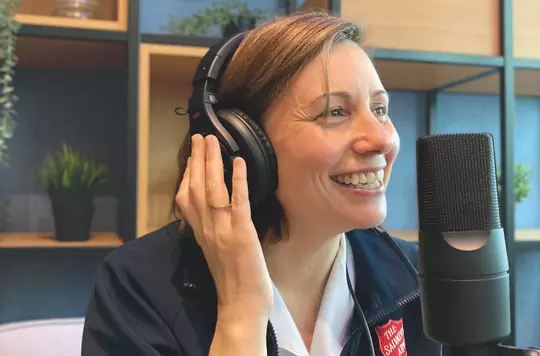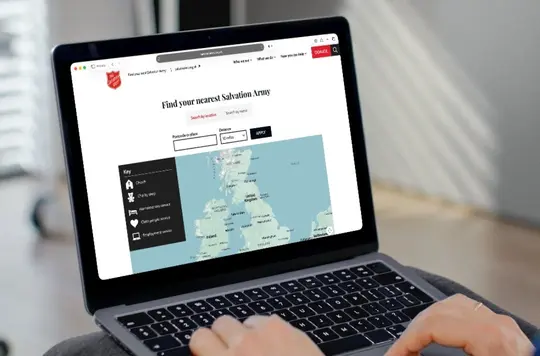10 May 2025
What does Christian mission look like in a digital age?

Online Content Editor Bethany Gibson (Publishing Department) talks about church, faith, evangelism and technology.
We like to think of technology as a new thing, but has adapting to it always been part of church?
Faith and church have always been mediated by something man-made. One key example was written communication and the printing press. But even within Scripture, we can see that different forms of media have different purpose and impact. In 2 John 12, we read: ‘I have much to write to you, but I do not want to use paper and ink. Instead, I hope to visit you and talk with you face to face.’
The early Christians wrote letters to one another. They used the media available to communicate. And there’s always been an understanding that there are things media can’t do that in-person communication can, and vice versa.
Do you see a difference between online and offline worship?
People often talk about online or offline worship in terms of how ‘present’ you can be but, even at in-person worship, it’s possible not to be present if the right forms of communication aren’t being used for you. For example, if you’re neurodivergent and the in-person environment causes sensory overload, you might not find it a place you can be comfortable and engaged. An online environment might be somewhere you feel more focused and present.
It’s not a case of one-size-fits-all or an either/ or choice – people can be engaged or not engaged, present or not present, in both online and offline worship. What matters are our connections with God and one another in those moments.
Has our understanding of online church changed in recent years?
Worship experiences can be quite transactional, for example when one voice is broadcasting to an audience, or they can be more interactive. When people traditionally think about online church, they are perhaps thinking about forms that are naturally broadcasting, because it involves a screen.
When the Covid-19 pandemic forced us to move church online, it helped people think about what’s important within their community’s worship experience – what we do, either in person or online, and why. Some digital tools will be useful, others not so much.
We often talk about church without walls and whole-life discipleship. That includes our online lives, doesn’t it?
Our lives are not contained to one place anymore. In the past, the radius in which you operated or travelled would have been quite small. Now, including digital platforms, we are in so many spaces.
Our faith experiences are happening in different communities, not just our local corps. We might consume social media content from another denomination or use an app from another faith organisation. We are journeying with Jesus alongside lots of different people. How much time we spend online or use a digital device will look different for each of us. The most important thing is who you are in all these different spaces and how the Spirit is shaping you.
So the digital world opens up ecumenical opportunities too?
Yes. A lot of churches are doing things already and we must remember we’re not in competition. Some Salvationists will use Lectio 365, for example, and some corps and IHQ have published reading plans on the Bible app for other people to use. The important thing is discerning what God is wanting us to do and be within this space.
What does the Army today look like digitally?
On a local level, there are corps – including Plexus – using social media, webpages and livestreams. There are online training courses, events held by Enabled, and interactive worship and prayer meetings over Teams or Zoom.
On a territorial level, we have salvationist.org.uk, which is the online place for people to explore faith and belonging with The Salvation Army, we have Salvationist Radio and podcasts, and we have a social media presence – both the Salvationist channels and the Army’s corporate channel, where we’re intentionally sharing faith content. We want what we’re doing at a territorial level to reflect and feel connected to what’s happening at a local level and vice versa. How can we be intentional about people entering our space wherever they come across the Army online?
How has Salvationist’s online presence developed over time?
It’s moving beyond us thinking about the channels through which we broadcast to think about the purpose and culture within these spaces. We’re now formally creating a digital faith and membership team that is focused on sharing the good news and nurturing disciples of Jesus. We want to help people feel connected across the territory, that they belong to something bigger. It’s great to meet at large events, but media helps us be connected in between those.
We have printed media, of course – my team exists alongside Salvationist magazine, Kids Alive! and War Cry – but digital has a powerful role to play, and together we’re looking holistically at what we’re doing in terms of membership and evangelism.
What’s next for the digital faith and membership team?
When we set up salvationist.org.uk, it was focused around membership but we knew we needed content for people who aren’t yet Christians as well. This need was reinforced by people on Google searching for how to become a Christian and finding our webpage salvationist.org.uk/becoming-christian. It feels Spirit-led – it would be like someone literally knocking on your hall every day! We’ve now worked with IHQ to provide a free ebook to people through that page called Who Is This Jesus Anyway? and we’re going to keep exploring the opportunities there.
To help do that, we are growing the digital faith and membership team – and, as well as collaborating with other departments, we’re working closely with the digital team within the wider Communications Service, where there’s been investment in lots of skills, including marketing and social media. We’ll be limited in what we can do, due to resources and capacity, but there’s so much potential for sharing the good news and nurturing disciples digitally. All those lessons we’ve learnt from in-person church – accessibility, inclusion, safeguarding – we need to translate into digital spaces as well.
What’s the most exciting thing for you right now?
I believe God’s got something to reveal to us of himself through digital technology. Throughout human history, we’ve used man-made things to help us experience the divine. Stained glass windows, candles, music, poetry. We have an understanding that when we make things, God can work through that. When people first started reading Scripture in their own language, that told them something about God who wanted to have a relationship with them. I think the same is true of digital – it’s not just about being connected or consuming content, but having a meaningful faith experience online to help us understand God in a new way.
In Beyond the Live and Zoomiverse, Philip Butler observes: ‘If God is in everything then God being in a machine is no real feat. At the very least, a machine can hold space for an individual to connect with God.’
We should exercise caution in how technology is used, of course, using the AI Guardrails and keeping in mind our values and mission. It’s important, in our always-on digital world, to remember the lesson of the Sabbath, that there’s more to life than doing. But so often, the commercial world is pioneering technology for profit. What if the Church was pioneering in this space as a way to get a bigger revelation of what God is like? That’s exciting!
Discover more

Captain Mark Scoulding (Watford) talks about the Artificial Intelligence Guardrails developed by the Moral and Social Issues Council.

An online radio station for anyone who wants to explore faith with The Salvation Army.

